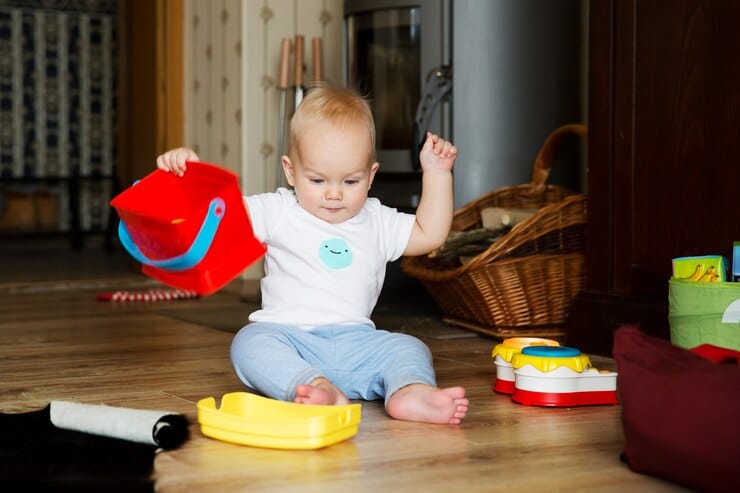Babies are born with excellent reflexes that help them move and interact with the world around them. Here are nine of the most famous reflexes:
1. The Cole reflex is when a baby starts or jerks their head to one side when they hear sudden noise or sees something unexpected.
2. The Moro reflex is a reaction where a baby pulls their arms towards their chest unusually when startled or touched.
3. The Urbach-Wiethe reflex is when a baby opens their mouth wide in surprise as if to scream.
4. The Bartlett reflex is when a baby turns their head to one side quickly after being banged on the chair abruptly, often causing an injury to the ear lobe or eyelids.
5. The Golland reflex happens when a baby looks away from an approaching object suddenly, followed by turning back towards it again very quickly – this can be seen as evidence of early learning skills and cognitive ls.
6. The Pons reflex is when a baby lifts one foot off the ground to avoid being stepped on and lowers it very quickly.
7. The Moro-Sereno reflex happens when a baby looks away from an object in their field of vision for too long, causing them to miss something that has suddenly appeared nearby; this can be seen as evidence of early learning skills.
9) Another famous reflex is the Fisherman’s Reflex – babies will lift both arms over their heads if they hear something unexpected approaching them from behind.
1. The Cole reflex
The Cole reflex is one of the first reflexes babies are born with. The Cole reflex helps babies survive in the womb by assisting them in breathing while they are still attached to the mother’s uterus via their umbilical cord.
The Cole reflex happens when you move your hand quickly towards your face and suddenly stop, causing your head and shoulders to jerk forward (the “jerk response”).
This movement redirects blood flow away from your arms and legs so they can continue supplying oxygen to your brain. Babies use this same instinctive reaction throughout their life as it helps them keep breathing, eat, drink, or avoid danger.
2. The Moro reflex
The Moro reflex is a reflex that babies are born with and helps them avoid danger. The reflex occurs when an infant’s head is turned suddenly to the side, causing their eyes to open very wide in surprise. This response allows infants to see around corners and avoid obstacles while learning to move around.
There are many different ways you can stimulate the Moro reflex in infants. One way is by playing games that involve turning your baby’s head quickly from side to side, such as “Catch That Cat.”
Another way is by massaging your baby’s forehead or temples with gentle pressure several times daily. And finally, singing nursery rhymes or lullabies close to your baby’s ears can also help stimulate the Moro reflex.
3. The Urbach-Wiethe reflex
The Urbach-Wiethe reflex is one of the most amazing reflexes that babies are born with. It’s a primary defence mechanism that helps newborns avoid danger.
The Urbach-Wiethe reflex happens when a baby sees something move and reacts before they realize what’s happening. For example, if you try to pick up your infant and he sees you coming, his first instinct will be to jerk away from you. This reaction is called the “Urbach-Wiethe reflex” because it was first described by two German scientists in 1907.
4. The Bartlett reflex
It’s easy to take the reflexes babies are born with for granted. But these simple motions can help prevent injuries and save lives.
The Bartlett reflex is when a baby lifts an arm or leg in response to touching its face. This helps them avoid obstacles, such as crib rails, while learning how to walk.
The ocular reflex is when a baby opens her eyes wide in response to seeing something new. This protects them from potential injury by allowing them to see where they’re walking before stepping on anything dangerous.
5. The Golland Reflex
The Golland Reflex is the reflex that helps babies regulate their body temperature. It’s also known as the startle response. It is responsible for making us recoil when our environment changes, such as when a rattlesnake approaches or a loud noise surprises us.
Babies are born with all these reflexes; some develop more quickly than others. The Golland Reflex happens most often within the first few months of life but can still be seen in toddlers up to around five years old. In this reaction, your baby will move away from whatever has scared them (in this case, the rattlesnake) while continuing to suck on their milk or drink if they’re thirsty.
6.The Chagas reflex
Babies are born with reflexes that help them survive in the world. The Chagas reflex is one such survival mechanism, and it can be life-saving.
The Chagas reflex happens when a baby’s immune system detects parasites like Trypanosoma cruzi (the parasite that causes Chagas disease) in their bloodstream. The body responds by initiating an inflammatory response that destroys the parasites while protecting the patient from further injury.
7. The Grashaevtsev Reflex
The Grashaevtsev reflex is a reflex that all babies are born with. It’s the ability to quickly and accurately orient oneself by a sense of sight, sound, touch, and smell. The reflex helps babies develop by allowing them to find their way around quickly and avoid dangerous situations.
8. Laparoscopic movements of the limbs and trunk
- Nine excellent reflexes that babies are born with
Babies are born with several reflexes, which include the following:
1. The rooting reflex
2. The sucking reflex
3. The facial grimace response
4. Pupil constriction (known as nystagmus)
5. Latex-induced vasoconstriction in newborns and children
Although most of these responses disappear by around two years old, they remain an exciting window into fetal development and provide valuable insights for pediatric medical professionals who treat infants and young children. Reflexologists can also use this information to help their patients respond better to treatments such as massage or acupressure reflexology.
9. Muscular flaccidity during sleep
Babies are born with a few essential reflexes that help them survive. One of these reflexes is muscular flaccidity during sleep, which allows the baby to develop necessary reflexes like breathing and heart rate regulation.
Muscular flaccidity during sleep happens when your muscles become limp and unresponsive to outside stimuli. This occurs because our brains are still active during REM (rapid eye movement) sleep and produce powerful muscle impulses.
These impulses cause your muscles to contract involuntarily, giving you that “floppy” appearance as they lay down or hang over the bedsheet while you slumber!
Conclusion
It’s no secret that reflexes are excellent, and babies are born with them in spades. In this blog post, we covered nine different reflexes that are all super important for survival.
By understanding how these reflexes work and how they help infants develop, you can make better decisions regarding your baby’s health and safety.











